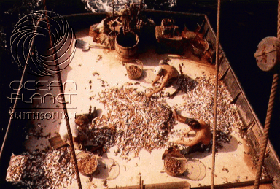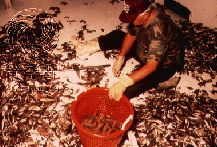So what's wrong with fish?
by David Ogilvie
Introduction
There are so many issues associated with modern fishing practices that it actually makes it difficult to justify the consumption of fish and seafood at all. Globally, the growing human population and seemingly insatiable desire for seafood coming at a great cost. Studies have shown that two-thirds of the world's fish stocks are being fished unsustainably. Many species are disappearing altogether and once thriving fisheries are collapsing.
People who reduce consumption of red meat often opt for fish and seafood as a 'healthy' alternative. The fact is that there is NO evidence implying that fish or seafood is necessary for optimal health. Omega-3 essential fatty acids can be obtained from other sources, and the believed dietary benefits of fish and seafood are questionable when their fat and cholesterol content, and often high levels of heavy metals and other contaminants, are considered.
On this page we outline the current status of fisheries around the world, cover some of the issues surrounding both commercial and recreational fishing, and discuss fish and human health.
Fisheries in crisis
Around the world, it is now generally acknowledged that our fisheries are in crisis. It is estimated that 90% of the world’s fisheries are overfished; more than 40% of the world's marine fishery populations are heavily to fully exploited; and 25% over-exploited, depleted or recovering.
The fundamental cause of the crisis is that the oceans' resources are considered infinite and inexhaustible. Deep water, rough water and distant water are no longer obstacles to modern fishing fleets, leaving no natural refuges for fish to escape and replenish.
In the distant past, fish, as a resource, were used at a sustainable rate and people caught only as many fish as they needed. Since the 1970s with the improvements in modern fishing technology, an increase in the number of people fishing, and an increase in global population, the impacts of fishing have been escalating.
Modern fishing fleets use a range of technology including aeroplanes, larger nets, radios, sea-floor maps, and video sonar to locate schools of fish. With improved technology and the introduction of purse seine nets, longline fishing, drift nets and factory trawlers, whole schools of fish are able to be caught easily.
As coastal fisheries have been depleted, developed nations, such as Canada, Japan, the USA and European countries, have improved their long-range fishing fleets to allow their ships to move further afield. Even the once less exploited oceans are now under threat of overfishing. New and previously unfamiliar deepwater species are being taken, and we are also fishing further down the food chain, with the development of pilchard, calamari and seajelly fisheries.
Closer to home, in the deep waters of the Southern Ocean, the orange roughy has also become the victim of overfishing. It was always going to be vulnerable, being a fish that grows slowly and does not breed until it reaches the age of 40 years (they live up to 150 years). This low productivity has made it impossible for orange roughy populations to recover after harvesting. In addition, their congregation around seamounts make them easy targets for trawl operations. Although Australia's orange roughy fishery only began in the 1980s, commercial fishing has reduced stocks by 80%.
Australia has also experienced declines in southern bluefin tuna, southern sharks and gemfish. Of the 100 fisheries described in Australian Fisheries Resources, published in 1993 by the Bureau of Resource Sciences and the Fisheries Research and Development Corporation, 9 were considered to be overfished, 23 fully or heavily fished, 9 underfished and 59 of unknown status.
By-catch - an incredible waste
Hi-tech fishing fleets not only catch greater numbers of commercial species of fish, but they also collect millions of tonnes of unwanted marine life each year, as well as destroy coral and other sea-floor resources.
By-catch is defined as any catch of species (fish, sharks, marine mammals, dolphins, seals, turtles, sea birds etc.) during fishery operations other than the target species.
By-catch has two components, the non-target species catch that is retained and the non-target species catch that is discarded. By definition, by-catch is pre-determined, while the decision to retain or discard may occur during the catching process, at some time later during the vessel trip, or, at times, on return to port. Unwanted or undersized animals culled from a catch are discarded - thrown back into the sea, dead or dying.
In the National Oceanic and Atmospheric Administration State of the Coast report (USA), it is estimated that approximately 27 million metric tons (30 million tons) of by-catch are discarded each year in the world's commercial fisheries, compared to a total of about 77 million metric tons (85 million tons) of landed catch. Much less information is available for recreational fisheries. (1)
 |
A shrimping crew culls the by-catch. Gulf of Mexico Commercial marine fisheries in the US alone toss away up to 20 billion pounds of by-catch each year - twice the commercial and recreational catch combined. |
| |
|
 |
Sorting catch and by-catch on a shrimpboat deck. Shrimpers tow nets that collect shrimp, and many other animals in their path. Red snapper, croaker, mackerel, sea trout, spot, drum, and other fishes - up to nine times more than the shrimp catch - are dumped overboard, already dead or dying. |
In shrimp trawl fisheries off the southern United States the issue of marine turtle by-catch came to wide public attention relatively recently, largely because of the estimated 48,000 sea turtles caught annually by shrimp fishermen. The US National Marine Fisheries Service estimates that more than 11,000 of these were dying annually. Only after intense pressure from environmental groups was remedial action taken to modify trawl nets in an attempt to exclude turtles from the catch.
|

